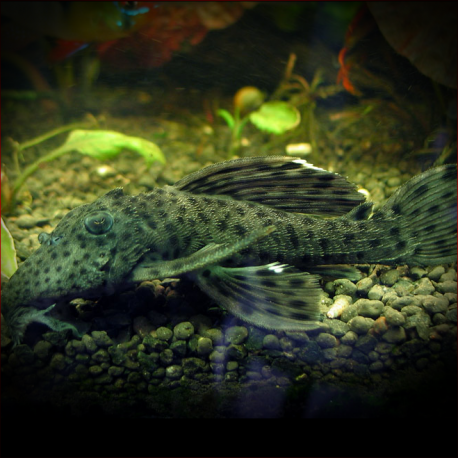More info
Datasheet
| Minimum Tank Size | 108 litres / 28.53 US gallons |
| Maximum Size | 15.0cm / 5.91inches |
| Temperature | 25°C / 77.00°F - 27°C / 80.60°F |
| Hardness | 2-15ºdH |
| pH | 6.0-7.5 |
General Description
Leporacanthicus Joselimai, commonly known as Sultan Plec or L264, belongs to the Ancistrinae subfamily within the Loricariidae family. This species is often referred to as "vampire plecs" due to the unique upper jaw dentition that includes two large fangs, possibly used for gripping prey like snails. With a maximum size of 15.0cm, they are visually striking when young with white fin tips that tend to fade as they mature. When purchasing, it is recommended to ensure the fish has a rounded belly and normal eye appearance to avoid emaciation issues in newly imported specimens.
Aquarium Setup
For optimal care, a spacious aquarium of at least 108 litres is recommended. The tank should feature a sandy substrate, hiding spots, shade provided by driftwood and smooth rocks, and dim lighting. The water must be highly oxygenated, preferably with significant water movement using powerheads or large airstones. An efficient filtration system is essential to manage the waste production of this species. Specific water conditions with a pH range of 6.0-7.5, hardness between 2-15 dH, and a temperature of 25-27°C should be maintained (see table).
Behaviour
Sultan Plecs are territorial, especially the males, and can exhibit aggression towards conspecifics if not provided with enough space and potential territories in the aquarium setup. They can be housed with characins, peaceful South American cichlids, and compatible catfish species such as Corydoras and small Loricariids. In a biotope setup with strong water movement, choices for tankmates may be more limited, possibly including Anostomus, Hemiodus, and reophilic cichlids like Retroculus or Steatocranus.
Feeding and Diet
These fish have a carnivorous diet consisting of live and frozen foods like bloodworms, chopped mussel, prawn, and sinking dried foods. Although they do not typically consume algae or vegetable matter, occasionally offering cucumber or courgette slices may be nibbled at by Sultan Plecs.
Reproduction & Dimorphism
Reproduction of Leporacanthicus Joselimai has been achieved in captivity, following a cave-spawning behavior similar to Ancistrus. Sexual dimorphism is observable in mature males, with longer and wider heads, larger dorsal fins, and more numerous odontotes compared to females.
Habitat and Distribution
Found in the Rio Tapajós region in Brazil, Sultan Plecs are reophilic species that thrive in fast-flowing waters near rocks and driftwood snags. Their natural habitat consists of rapids and similar environments that provide ample hiding spots and shelter.

